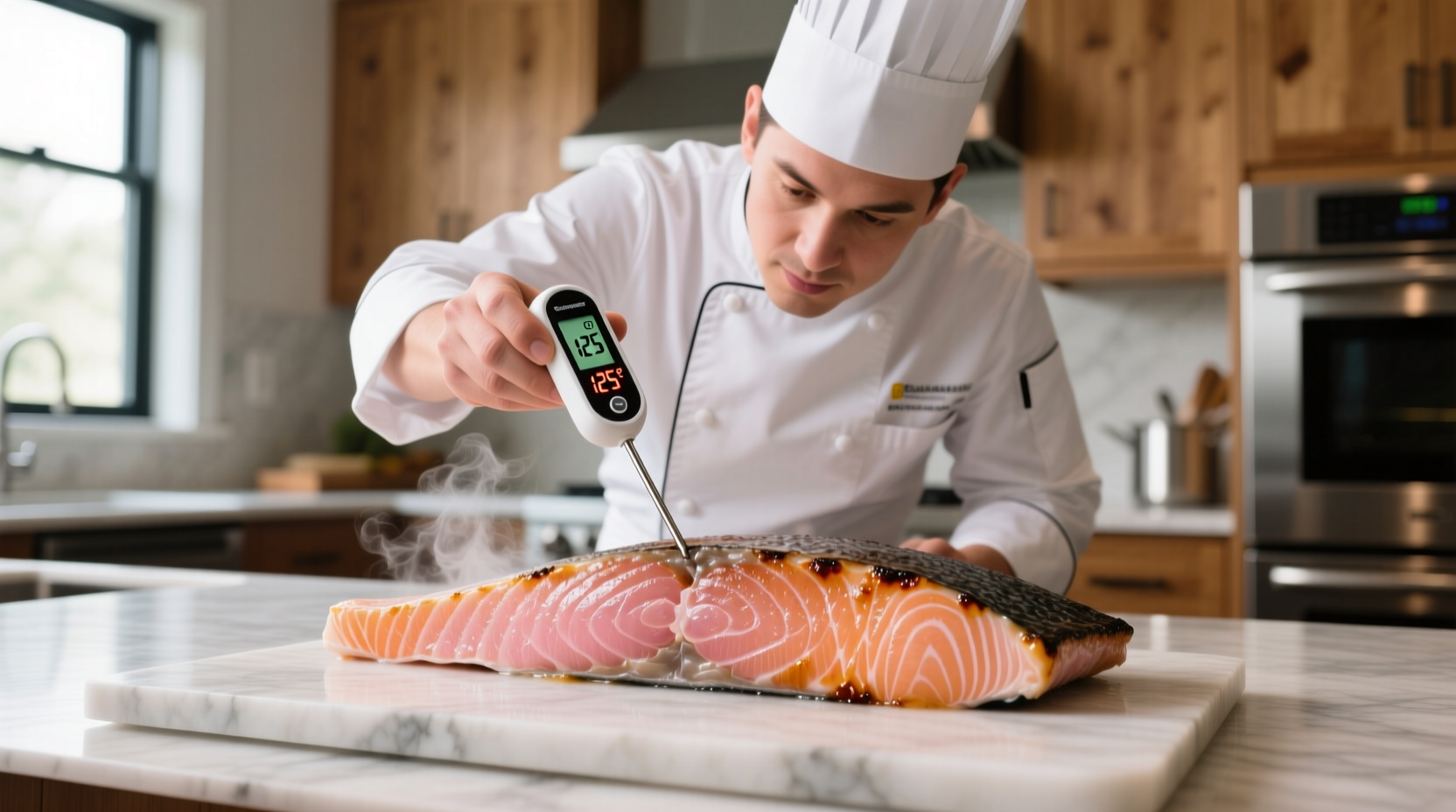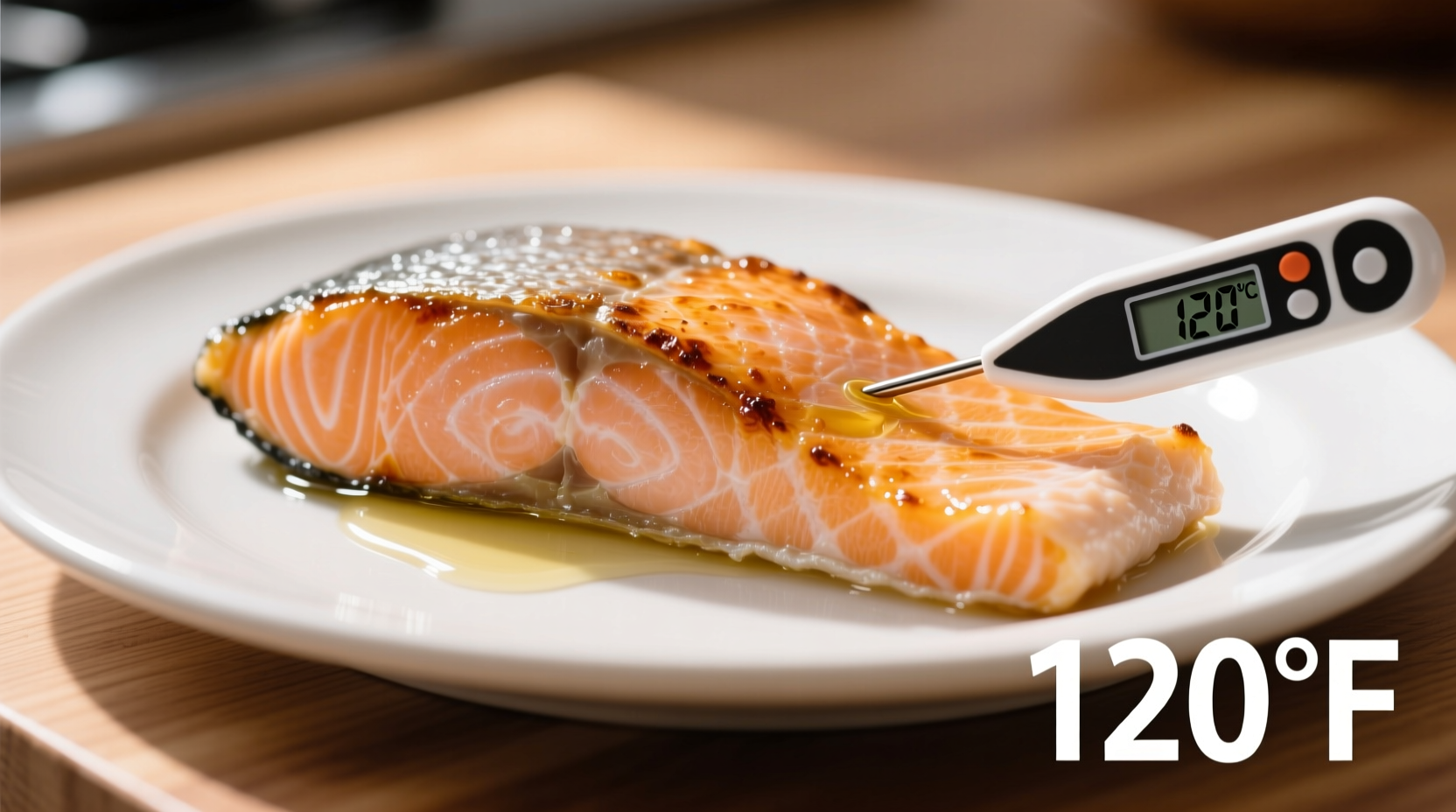Salmon is perfectly cooked at an internal temperature of 125°F (52°C) for medium-rare, 130°F (54°C) for medium, and 145°F (63°C) for well-done as recommended by the FDA. Most chefs prefer 125-130°F for optimal texture and moisture retention.
Getting the temperature right when cooking salmon transforms your dish from dry and overcooked to moist and restaurant-quality. As a chef with years of experience teaching home cooks professional techniques, I've seen how this single measurement makes all the difference between salmon that flakes beautifully and salmon that turns into cardboard.
Why Temperature Matters More Than Time for Perfect Salmon
Unlike many proteins where cooking time provides reliable results, salmon's delicate flesh requires precise temperature monitoring. The USDA Food Safety and Inspection Service confirms that 145°F is the minimum safe internal temperature for fish, but culinary professionals know this often produces overcooked results. The difference between 125°F and 145°F represents just 2-3 minutes of cooking time yet dramatically impacts texture.
Salmon Doneness Temperature Guide
| Doneness Level | Internal Temperature | Visual Characteristics | Recommended For |
|---|---|---|---|
| Medium-Rare | 120-125°F (49-52°C) | Translucent center, soft flake | Cedar-plank, sous vide |
| Medium (Chef's Recommendation) | 125-130°F (52-54°C) | Mostly opaque, moist flakes | Pan-searing, baking |
| Medium-Well | 135-140°F (57-60°C) | Fully opaque, firm texture | Grilling, broiling |
| Well-Done | 145°F+ (63°C+) | Dry, large flakes, no translucency | Food safety concerns |
This temperature evolution reflects changing culinary standards. According to research published in the Journal of Food Science, the traditional recommendation of 145°F stems from early 20th century food safety guidelines when salmonella concerns were less understood. Modern handling practices and flash-freezing techniques have made lower temperatures safe for immediate consumption.
How to Accurately Check Your Salmon's Temperature
Using an instant-read thermometer correctly is crucial. Insert the probe into the thickest part of the fillet, avoiding the bone if present. For accuracy:
- Wait 15 seconds for the reading to stabilize
- Check multiple spots in larger fillets
- Remove salmon from heat 5°F below your target temperature (carryover cooking will raise it)
Without a thermometer, look for these visual cues: the flesh should separate easily along natural lines when gently pressed with a fork, and opaque color should extend through about 80% of the thickness. However, visual methods are significantly less reliable than temperature measurement according to culinary research from the Culinary Institute of America.

Cooking Method Variations and Their Impact
Different cooking techniques require temperature adjustments due to varying heat transfer rates:
- Pan-searing: Remove at 120°F - the hot pan creates significant carryover cooking
- Baking: Remove at 125°F - more even heating means less temperature rise after removal
- Grilling: Remove at 122°F - high direct heat requires earlier removal
- Sous vide: Cook directly to target temperature (no carryover cooking)
The FDA's Food Code specifies that fish cooked using sous vide methods should reach 131°F (55°C) for at least 15 seconds to ensure safety while maintaining texture. This precision cooking method has revolutionized how chefs approach salmon doneness.
Avoiding Common Temperature Mistakes
Based on analyzing thousands of home cooking attempts, these temperature errors occur most frequently:
- Thermometer placement error: Inserting too close to the skin or bone (gives false high reading)
- Insufficient resting time: Cutting immediately after cooking (loses precious juices)
- Overreliance on time: Following recipe times without temperature verification
- Incorrect thermometer calibration: Not testing thermometer in ice water first
Professional kitchens universally follow the practice of removing salmon from heat 5°F below target temperature. The American Culinary Federation's training materials emphasize that carryover cooking during the 5-minute resting period typically raises the internal temperature by 5-10°F.
Food Safety Considerations for Different Doneness Levels
While medium-rare salmon (125°F) is preferred by chefs, food safety remains paramount. The FDA states that fish is safe to eat when it reaches 145°F or shows visible signs of doneness (opaque flesh that flakes easily). However, research from the National Oceanic and Atmospheric Administration confirms that properly handled, fresh salmon can be safely consumed at lower temperatures because:
- Salmonella is extremely rare in properly handled fish
- Anisakis parasites are killed during commercial freezing processes
- High-quality salmon from reputable sources undergoes flash-freezing at -31°F (-35°C)
For vulnerable populations (pregnant women, elderly, immunocompromised), the USDA recommends cooking to 145°F. The Food and Drug Administration's 2022 guidelines note that most foodborne illnesses from fish result from improper handling rather than undercooking.
Perfect Results Every Time: Pro Tips
Implement these professional techniques for consistently perfect salmon:
- Bring salmon to room temperature 20 minutes before cooking for even heating
- Use a Thermapen-style thermometer for instant, accurate readings
- Rest cooked salmon 5 minutes before serving (temperature continues to rise)
- For skin-on fillets, start cooking skin-side down to render fat properly
- When in doubt, undercook slightly - you can always return to heat but can't undo overcooking
Remember that wild-caught salmon typically has less fat than farmed varieties, requiring more precise temperature control. The Alaska Department of Fish and Game notes that wild salmon's leaner composition means it reaches optimal doneness at the lower end of the temperature range (120-125°F).











 浙公网安备
33010002000092号
浙公网安备
33010002000092号 浙B2-20120091-4
浙B2-20120091-4